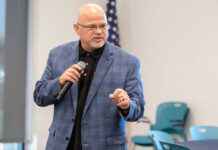
Over the last several months we’ve spent some time together talking about some of the challenges and options involved in the creation of the County’s Tentative Budget for fiscal year 2010.
This year’s budget deliberations by the Board are some of the most difficult we’ve had to have in decades. Dwindling revenues from all sources and no sign of a true short-term economic recovery any time soon mean to me that the Board’s options are limited as we consider how to balance income against expenditures. No whining – just time for a reality check.
Some of the cost-saving/budget expenditure measures either already in place or slated for full implementation for the new fiscal year: a countywide hiring freeze (PCSO excepted), a virtual elimination of take-home vehicles, an early retirement/incentive package and budget reductions that affected virtually all of the county’s elected offices and administrative departments. Many of these measures were not only necessary to get us through the current fiscal year, but they’re also necessary for a balanced budget for the coming fiscal year. We also moved approximately $9.5 million from our fund balance this budget year to keep our employees’ wages whole against the wholesale reduction in revenues (i.e. sales tax, permit fees, state-shared revenues, etc.).
Let me take a moment to explain what fund balance is. This is not, as some have characterized it, some kind of ‘slush fund.’ This is essential money the county keeps on reserve that we could borrow against if faced with a catastrophic event such as a massive flood, catastrophic financial failure or other widespread emergency. If a flood took out part of the county complex or a major road, we need to have funding available to secure credit at favorable terms. If our fund balance is depleted, the consequence is that we are not credit worthy or we are less credit worthy. It would cost taxpayers significantly more to borrow if we do not maintain a healthy reserve.
When we look forward to next year’s budget (FY2010), however, there are some additional measures deemed necessary to bring the budget into balance. Those proposed measures – reductions in force and a reduction in wage – and the shape of the proposed Fiscal Year 2010 budget were recently addressed during two successive meetings of the Board last month. I can assure you that any decision I make on reducing staff and/or reducing wages is difficult for me and involves a lot of prayer and soul-searching. But the bottom line to our FY2010 budget problem is: how do we bridge a $5 million gap between revenues and expenditures?
The primary choices are, as I see it, to either dip into our fund balance or lay off more employees OR reduce salaries across the board. Choices such as laying off more than the approximately 50 employees currently proposed to come from the non-public safety side of our organization. Choices such as such as taking all $5 million from the budget balance in order to keep salaries whole. And what are our options if revenues haven’t improved for FY2011? Will the Board be back at this same decision point a year from now with the prospect of even deeper reductions to make? My guess is very likely yes.
As we evaluate various options, I must clarify one piece of misperception: the proposed FY2010 budget includes a line item of $12 million for ‘Capital Facilities’ (i.e. construction or modification to county buildings for the purposes of expansion). This line item is included for budget authority but has NO revenue attached to it. In other words, nothing will take place in conjunction with this account unless new (not included in our revenue projections) money is found and brought into the county’s coffers. Therefore, this ‘$12 million account’ can’t be part of the solution to our challenge.
As we work through this year’s process I have heard from a number of county employees about their feelings on the prospect of a salary reduction. At this point PCSO and probation have been ‘spared the pain’ of hiring freezes and layoffs — unlike any other part of the county organization. Our choices are: consume our budget balance/savings account, institute deeper layoffs (above and beyond the 82 positions already contemplated from non-public safety departments) and/or implement an across the board salary reduction. The Board of Supervisors has the entire organization to consider … and if we do either of the latter two or a combination thereof, I cannot in good conscience continue to hold public safety harmless.
There are those who argue that public safety positions should be exempt from any reductions in staff, budget or salary. I believe that if there is ‘pain’ to be felt in our county’s budget, it ought to be shared equitably. In my opinion, the Public Works employee maintaining our roads, the Animal Control officer responding to calls for help controlling wild animals that threaten residents and the Public Health nurses healing babies and counseling mothers-to-be, are as important as the deputy responding to traffic accidents or other public safety incidents. To say that one category of employee is more important or critical (and thus unilaterally exempt from budget impacts) ignores the fact that a well-engineered, balanced organization demands that all disciplines share in the hard times and the good times.
We continue to explore our options as we work toward agreement on a balanced budget for FY2010. No final decisions have been made. However, let me reassure you on one point: IF salary reductions are implemented, I am committed to restoring our salaries and wages as soon as our revenues come back to an appropriate and sustainable level. Unfortunately, the high level presentations concerning prospects for a quick recovery that I continue to hear are fairly pessimistic for the near and middle term. Therefore, I find it even more imperative that our final budget decisions be prudent, conservative and sustainable in the face of continued raids on our revenue streams by the state legislature and other downward trends in traditional revenue sources.
David Snider, Supervisor
Pinal County District 3
File photo









![Maricopa restaurateur makes Food Network connection [Namkeen Dhaba]](https://www.inmaricopa.com/wp-content/uploads/2024/04/439456716_377105198650519_7536248579664805896_n-218x150.jpg)
![City gave new manager big low-interest home loan City Manager Ben Bitter speaks during a Chamber of Commerce event at Global Water Resources on April 11, 2024. Bitter discussed the current state of economic development in Maricopa, as well as hinting at lowering property tax rates again. [Monica D. Spencer]](https://www.inmaricopa.com/wp-content/uploads/2024/04/spencer-041124-ben-bitter-chamber-property-taxes-web-218x150.jpg)



![O’Reilly gears up for second Maricopa location An exterior view of O'Reilly Auto Parts on John Wayne Parkway on May 2, 2024.[Monica D. Spencer]](https://www.inmaricopa.com/wp-content/uploads/2024/05/spencer-050224-oreilly-second-location-web-100x70.jpg)
![Province writer opens the athlete’s mind in new book Tom Schuman, a Province resident, poses with a copy of his new book, "My Wide World of Sports," outside his home on May 2, 2024. [Monica D. Spencer]](https://www.inmaricopa.com/wp-content/uploads/2024/05/spencer-050224-tom-schuman-sports-book-web-01-100x70.jpg)